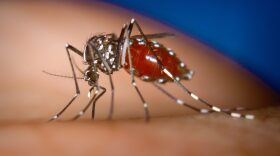Researchers at the University of Hawaiʻi found that cattle and pigs play a fatal role in the spread of disease for ʻōhiʻa lehua trees on Hawaiʻi Island.
ʻŌhiʻa lehua trees, an endemic species to Hawaiʻi, make up 80% of the state forests. However, a fungal disease known as Rapid ʻŌhiʻa Death, or ROD, has been infecting and killing the trees for nearly a decade.
The UH study found that damage to healthy trees caused by hooved animals digging up roots and stripping off bark increases the plant's risk of catching ROD, according to experts.
Researchers say the issue underscores the need for fencing to protect ʻōhiʻa from further infection. They have released an online map showing the hardest hit areas on Hawaiʻi Island without fences to keep hooved animals out.
Brian Tucker, a data specialist at UH Mānoa, said that monitoring ʻōhiʻa forests is a top priority.

“These observations help guide our research projects, forest management practices and public outreach,” Tucker said in a news release.
“We noticed a trend where the forests have less mortality due to ROD when protected from feral animals, especially cattle and pigs. We love our forests, and it gives us hope because there are tools available for meaningful action to minimize the most devastating effects of ROD.”
The data was collected from January 2019 to 2023 using remote-sensing technology, high-resolution satellite and helicopter images. The images show how fences protect the trees from animals that may spread the fungus.
The satellite image from October 2022 shows two fenced areas of Hawaiʻi Volcanoes National Park, where 99% of more than 3,000 trees impacted by the disease were in unfenced areas.
“This imagery is used to identify individual dying ʻōhiʻa trees and can be used to direct field crews for sampling and ultimately lab analysis to confirm ROD infection,” said Na‘i Odachi, a UH Hilo student and geospatial analyst.





